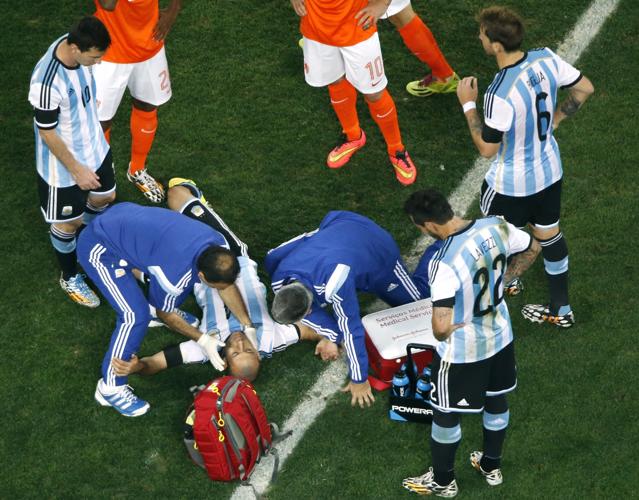Opinion
FootballFIFA’s cowardice on head injuries is shocking and shameful
/dnl.eurosport.com/sd/img/placeholder/eurosport_logo_1x1.png)
Updated 15/06/2021 at 20:34 GMT
This article was initially written in the summer of 2014, when players at the World Cup in Brazil incurred head injuries and were permitted to play on. Seven years on, it's just as relevant - as we saw when Benjamin Pavard was knocked out with a flying knee in the Euro 2020 match between France and Germany and stayed on the pitch. For all the talk, nothing has changed.
Germany's defender Robin Gosens (L) collides with France's defender Benjamin Pavard
Image credit: Getty Images
From July 2014
Another football match, another head injury – and out come the fawning accolades for a player's bravery, determination and commitment to his team’s cause as he plays on.
Argentina’s Javier Mascherano looked utterly bewildered after hitting his skull against Netherlands' Georginio Wijnaldum’s in their World Cup semi-final, but insisted he would be fine to continue.
Alvaro Pereira of Uruguay did the same against England earlier in the tournament as his head took the full force of Raheem Sterling's knee, and players’ union FIFPro called then for an investigation into how the sport dealt with potential concussions.
Managers, team-mates, fans and the media are doing sportspeople absolutely no good whatsoever with their eagerness to praise anyone who plays on after a knock to the head.
Continuing to play is not a badge of honour; it’s a mark of irresponsibility, and, perhaps contrarily and counterintuitively, unprofessionalism.

There is a very strong base of evidence in sports science that demonstrates the dangers of athletic exertion after a head trauma.
Any athlete suspected of having a concussion should - indeed, must - be stopped from playing and assessed thoroughly. An immediate return to the field after a physio has cursorily waved a finger in front of his or her eyes is insufficient.
Concussion can take a while to set in, and management and medical staff should err on the side of caution. An athlete needs to be monitored closely for days – and weeks – afterwards, with a gradual return to competitive play.
Rugby acknowledges it, with proper rules to manage such injuries, and a focus on ensuring the player’s wellbeing comes above all else.
Snow sports acknowledge it, with elite competitions requiring protective head gear, with a recommendation extended to leisure participants. The data suggest that helmet use in snow sports reduces the risk of head injury by around 35 per cent.
Even professional wrestling – which consistently gets mocked by sports fans for not being “real”, but still entails very real contact and risks – acknowledges it, with WWE now outlawing any deliberate shots at the head, and removing performers from shows to give them recovery time after incurring a head injury. (Indeed, former wrestler Christopher Nowinski now leads the Sports Legacy Institute, which raises awareness about the dangers of sports concussion, and is co-director of a brain injury research centre at Boston University.)
FIFPro are arguing that independent medical professionals should conduct a sideline concussion assessment, whereas FIFA maintains the ultimate responsibility lies with the team doctor – who might have their judgement affected by their investment in the situation.
Above all, it certainly shouldn’t be left up to the player.
Pereira apologised for overruling the Uruguay team doctor who had wanted to substitute him, explaining:
It was that moment your adrenaline flowing in your body, maybe without thinking ... what I really wanted to do was to help get the result.
Vincent Kompany of Belgium played on in a World Cup qualifier after breaking his nose, fracturing his eye socket and sustaining a concussion, and afterwards reflected: “I would always listen to what the medical staff has to say but, then again, I would do the opposite of what the medical staff would say… You have to take emotions and adrenaline into account. Unless someone puts on the emergency brake, you are not going to do it yourself.”
That final point is key. Football’s nebulous “guidelines” have to be turned into hard and fast rules, and those rules have to be enforced.
It’s not like football clubs and authorities don’t know about this. There’s a recent and updated Sport Concussion Assessment Tool (SCAT3 for short) that FIFA recommend should be used for diagnosis.
That FIFA recommend rather than enforce this diagnostic procedure is nothing less than shameful. It shows that they know full well what best practice is, but choose to abdicate responsibility to individual team doctors, knowing that makes it far less likely that teams' stars are withdrawn from action. This failure to ensure the gold standard is followed on football's biggest stage is, quite simply, a disgrace to the game.
SCAT3 recommends treating a head injury as a concussion if a player loses consciousness, if they’re lying motionless on the ground, if they’re slow to get up, if they look dazed, if they’re unsteady on their feet, or if they’re confused. Any single one of those symptoms should be enough for someone to be removed from the field of play.
And we very rarely see that in top flight men’s football, where the culture of bravado, the pursuit of success and the valorisation of the consequent money trump all - even at the expense of the safety of its players.
Scan me
Related Topics
Share this article
Advertisement
Advertisement